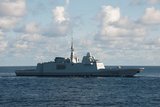US Army completes field testing of Northrop Grumman-developed next-generation FBCB2 software
The US Army has completed formal evaluation of the next-generation software version of the Force XXI Battle Command Brigade and Below (FBCB2), developed by Northrop Grumman Corporation . Field testing of the new software, called Joint Capabilities Release (JCR), was conducted at Fort Hood, Texas, from Sept. 28 to Nov. 20, 2009.
FBCB2 is the key situational awareness and command-and-control system used by US and coalition forces in Iraq and Afghanistan. The JCR upgrades include a significant increase in the network's bandwidth, allowing the combat-proven system to get more information to more users within seconds rather than minutes. It also provides a joint forces platform solution for both the Army and US Marine Corps.
The Army and Marine Corps continue conducting a series of planned tests at Fort Hood's Central Technical Support Facility and at Camp Pendleton, Calif., in the Marine Corps Tactical Systems Support Activity. Testing of the improved data throughput will continue throughout 2011, after the Army awards a production contract for an improved Blue Force Tracking 2 (BFT2) transceiver.
The services expect to decide whether to field JCR in late summer 2010.
"JCR will provide soldiers and Marines with powerfully enhanced capabilities in command-and-control and situational awareness," said Joe G. Taylor, Jr., vice president of the Ground Combat Systems operating unit within Northrop Grumman's Information Systems sector. "We are very optimistic a positive decision will be reached, and JCR will be fielded to operational units starting as early as October."
During last fall's field testing, evaluators examined the effectiveness, reliability and performance of the system for both Army and Marines, in various military vehicles, tactical operations centers, called TOCs, and combat operations centers. The test was conducted in a distributed environment and supported by active-duty military and civilian personnel from several government agencies.
Northrop Grumman completed system segment acceptance testing and delivered JCR to the US Army Communications-Electronics Command, Fort Monmouth, N.J., in September 2009.
Northrop Grumman developed JCR using an approach based on a common set of core assets, making it more modular, reusable, interoperable and easier to upgrade. This Battle Command Product Line architecture is capable of supporting multiple products for a variety of users, including aviation, dismounted soldiers, logistics and fires.
JCR will be fielded to 96 percent of all Army and Marine Corps platforms that are scheduled to receive digital battle command systems. To date, more than 85,000 FBCB2 systems have been deployed worldwide.
FBCB2 links communication devices, sensors, vehicles, rotary-wing aircraft and weapons platforms in a seamless digital network to provide a clear, continuous and common picture of the battlefield. Most FBCB2 systems communicate via a satellite-based network; about 30 percent use the Enhanced Position Location Reporting System, or EPLRS, tactical radio network.
The company was awarded the first FBCB2 software development contract in January 1995.
Source: Northrop Grumman
More from Digital Battlespace
-
![Babcock nears first customer for Nomad AI translation tool]()
Babcock nears first customer for Nomad AI translation tool
Nomad can provide militaries with real-time intelligence, saving critical time on the battlefield.
-
![AUSA 2025: Israel’s Asio Technologies to supply hundreds of improved Taurus tactical systems]()
AUSA 2025: Israel’s Asio Technologies to supply hundreds of improved Taurus tactical systems
Taurus operates alongside the Israel Defense Forces’ Orion system which supports mission management across tens of thousands of manoeuvring forces, from squad leaders to battalion commanders.
-
![AUSA 2025: Kopin pushes micro-LED plans as China moves faster]()
AUSA 2025: Kopin pushes micro-LED plans as China moves faster
The plan for the new displays follows fresh investment in Kopin’s European facilities by Theon and an order for head-up displays in fielded aircraft, with funding from the US Department of Defense.
-
![AUSA 2025: Persistent Systems to complete its largest order by year’s end]()
AUSA 2025: Persistent Systems to complete its largest order by year’s end
Persistent Systems received its largest ever single order for its MPU5 devices and other systems earlier this month and has already delivered the 50 units to the US Army’s 4th Infantry Division.
-
![Aselsan brings in dozens of companies and systems under the Steel Dome umbrella]()
Aselsan brings in dozens of companies and systems under the Steel Dome umbrella
Turkey has joined the family of countries attempting to establish a multilayered air defence system with government approval in August 2024 for the effort landed by Aselsan. Dubbed Steel Dome, the programme joins Israel’s Iron Dome, the US Golden Dome, India’s Mission Sudarshan Chakra and South Korea’s low-altitude missile defence system.
-
![DSEI 2025: MARSS unveils new agnostic multidomain C4 system]()
DSEI 2025: MARSS unveils new agnostic multidomain C4 system
MARSS’ NiDAR system has been deployed using sensors from static platforms to provide detection and protection for static sights, such as critical infrastructure, ports and military bases.



























